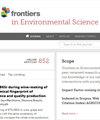Microplastics in indoor dust at Dhaka city: unveiling the unseen contaminants within our homes
IF 3.3
3区 环境科学与生态学
Q2 ENVIRONMENTAL SCIENCES
引用次数: 0
Abstract
Indoor environments, considered sanctuaries from external pollutants, are increasingly recognized as reservoirs for microplastics (MP). This research employed a comprehensive approach, combining dust sampling from diverse indoor spaces, density separation method, and microscopic observation to quantify and characterize microplastic particles. This is the first initial study worldwide that incorporated MP identification in indoor dust from different indoor environments along with factor analysis, health, and ecological risk assessment. The average MP concentration in the indoor environment was 4333.18 ± 353.85 MP/g. The MP distribution pattern was in institutional areas < residential areas < industrial areas < and commercial areas. Black color, fiber, <0.5 mm size was the dominant color, morphology, and size, respectively, among the detected MP from the studied samples. In addition, the polymer types of the MP were detected by Fourier Transform-Infrared (FT-IR) spectroscopy, and ten types of polymers were detected while PET was in high abundance. Population number, architectural features of habitat, human activities, urban topography, and particle residence time were determined as responsible factors for MP abundance in indoor areas. The estimated daily intake (EDI) value via ingestion was higher than the inhalation of MP. Infants are highly susceptible to MP exposures. According to Polymer Hazard Index (PLI) and Polymer Hazard Index (PHI) values, the exposure risk was in the minor and extreme risk categories.达卡市室内灰尘中的微塑料:揭示我们家中看不见的污染物
室内环境被认为是外部污染物的避难所,但越来越多的人认识到室内环境是微塑料(MP)的储藏所。这项研究采用了一种综合方法,将不同室内空间的灰尘采样、密度分离方法和显微镜观察相结合,对微塑料颗粒进行量化和定性。这是世界上首次将不同室内环境的室内灰尘中的 MP 识别与因素分析、健康和生态风险评估相结合的初步研究。室内环境中 MP 的平均浓度为 4333.18 ± 353.85 MP/g。MP的分布模式为机构区< 居住区< 工业区< 和商业区。在研究样本中检测到的 MP 中,黑色、纤维状和 0.5 mm 尺寸分别是主要的颜色、形态和尺寸。此外,还利用傅立叶变换红外光谱(FT-IR)检测了 MP 的聚合物类型,共检测到 10 种聚合物,其中 PET 的含量较高。人口数量、栖息地的建筑特征、人类活动、城市地形和粒子停留时间被确定为室内地区 MP 丰度的影响因素。通过摄入MP的估计日摄入量(EDI)值高于吸入量。婴儿极易接触到多溴联苯。根据聚合物危害指数(PLI)和聚合物危害指数(PHI)值,接触风险属于轻微和极端风险类别。
本文章由计算机程序翻译,如有差异,请以英文原文为准。
求助全文
约1分钟内获得全文
求助全文
来源期刊

Frontiers in Environmental Science
Environmental Science-General Environmental Science
CiteScore
4.50
自引率
8.70%
发文量
2276
审稿时长
12 weeks
期刊介绍:
Our natural world is experiencing a state of rapid change unprecedented in the presence of humans. The changes affect virtually all physical, chemical and biological systems on Earth. The interaction of these systems leads to tipping points, feedbacks and amplification of effects. In virtually all cases, the causes of environmental change can be traced to human activity through either direct interventions as a consequence of pollution, or through global warming from greenhouse case emissions. Well-formulated and internationally-relevant policies to mitigate the change, or adapt to the consequences, that will ensure our ability to thrive in the coming decades are badly needed. Without proper understanding of the processes involved, and deep understanding of the likely impacts of bad decisions or inaction, the security of food, water and energy is a risk. Left unchecked shortages of these basic commodities will lead to migration, global geopolitical tension and conflict. This represents the major challenge of our time. We are the first generation to appreciate the problem and we will be judged in future by our ability to determine and take the action necessary. Appropriate knowledge of the condition of our natural world, appreciation of the changes occurring, and predictions of how the future will develop are requisite to the definition and implementation of solutions.
Frontiers in Environmental Science publishes research at the cutting edge of knowledge of our natural world and its various intersections with society. It bridges between the identification and measurement of change, comprehension of the processes responsible, and the measures needed to reduce their impact. Its aim is to assist the formulation of policies, by offering sound scientific evidence on environmental science, that will lead to a more inhabitable and sustainable world for the generations to come.
 求助内容:
求助内容: 应助结果提醒方式:
应助结果提醒方式:


